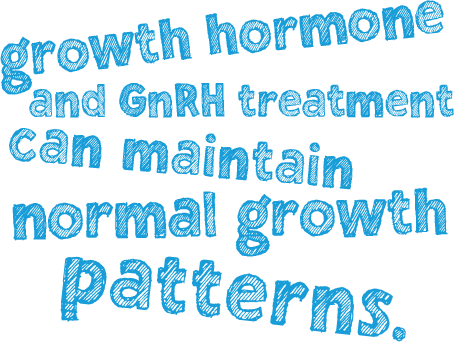
Precocious Puberty

Precocious puberty involves a child’s body reaching puberty before age 8 (for girls) and age 9 (for boys). When present, young children begin to exhibit tell-tale signs of adulthood, such as a deeper voice, facial hair, menstruation, and accelerated growth. Often, doctors prescribe gonadotropin-releasing hormone to manage these symptoms. Unfortunately, this can have adverse effects on adult height, which is where growth hormone comes in.
What Causes Precocious Puberty?
Doctor’s still don’t fully understand the mechanism behind precocious puberty. However, hypothyroidism has been confirmed as a main driver of precocious puberty. Typically, this causes overproduction of gonadotropins. Medical interventions therefore target this hormone. In some cases, infection or brain abnormality/injury result in precocious puberty.


Symptoms include:
• Breast growth
• Early onset of period
• Enlarged reproductive organs
• Facial hair and deepening voice
• Development of pubic or armpit hair
• Acne
• Rapidly accelerated growth
• Body odor
Diagnosis and Treatment
In order to get a proper diagnosis, your child’s doctor will need to conduct a variety of tests. These exams may include:
• A comprehensive review of your family medical history
• A physical
• X-rays of the hand and wrist
• Gonadotropin-releasing hormone stimulation test
Depending on the results, your child may receive an official diagnosis of central or peripheral precocious puberty. Afterwards, treatment can begin.


Treatment is highly specific to each case. Therefore, your child may need immediate medical intervention, or a doctor may want to wait and monitor progress. Medical treatment typically involves something called gonadotropin-releasing hormone (GnRH) analog therapy. In this process, a child experiencing precocious puberty injects GnRH medication once a month until they reach the normal age of puberty. Additionally, your child can get a surgical implant that releases medication on schedule. Treatment ends when a doctor determines your child can begin regular stages of puberty.
Growth Hormone Therapy For Precocious Puberty
Children currently on GnRH analog therapy often have a problem with growth. Even without GnRH, kids can end up below the fifth percentile in height as adults. Enter growth hormone therapy.
A combination of recombinant growth hormone and GnRH treatment can maintain normal growth patterns. Studies show this combination leads to higher growth frequencies than GnRH therapy alone.


Side Effects of Growth Hormone Therapy and GnRH
First of all, side effects of gonadotropin-releasing hormone analog therapy include:
• Headache
• Hypoestrogenism
• Osteoporosis or bone density issues with long-term treatment
Additionally, look out for the following with use of growth hormone therapy:
• Rash, redness, or pain at injection site
• Fever
• Progression of existing scoliosis
• Insulin resistance
• Any edema
Studies confirm the safety of HGH and GnRH analog therapy in large groups of patients with central precocious puberty. However, as with any medical intervention, treatment should always occur under the careful guidance of a doctor.
Cost of Growth Hormone Therapy in Mexico
Unfortunately, many insurance companies don’t cover growth hormone therapy. In order to get coverage, one must prove growth hormone is a medical necessity.
This can be difficult to prove with precocious puberty. Of course, children normally age at different rates. Therefore, insurance companies can deny coverage with that claim. When this happens, parents end up paying thousands of dollars a month out of pocket.
Fortunately – we’ve got you covered. The cost of growth hormone therapy in Mexico is significantly cheaper. Without Big Pharma hiking prices, the same medication in Mexico costs a fraction of what it sells for in the USA. You can even afford a vacation to Mexico, meet with an endocrinologist, get medication, and fly home for less than the cost of growth hormone therapy in America.


